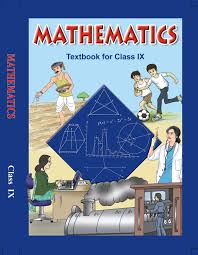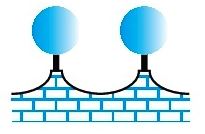Class 9 - Mathematics
Surface Areas and Volumes - Exercise 13.9

Top Block 1
Question : 1 : A wooden bookshelf has external dimensions as follows: Height = 110 cm, Depth = 25 cm, Breadth = 85 cm (see Fig.).
The thickness of the plank is 5 cm everywhere. The external faces are to be polished and the inner faces are to be painted.
If the rate of polishing is 20 paise per cm2 and the rate of painting is 10 paise per cm2, find the total expenses required for polishing and painting the surface of the bookshelf.

Answer :
Here, Height = 110 cm, Depth = 25 cm
Breadth = 85 cm, Thickness of the plank = 5 cm
Area to be polished = [(110 * 85)] + [(85 * 25) * 2] + [(110 * 25) * 2]
+ [(5 * 110) * 2] + [(75 * 5) * 4]
= 9350 + 4250 + 5500 + 1100 + 1500
= 21700 cm2
Cost of polishing at the rate 20 poise per cm2 = Rs (20/100) * 21700
= Rs 21700/5
= Rs 4340
Area to be painted = [(75 * 20) * 6] + [(90 * 20) * 2] + [90 * 75]
= 9000 + 3600 + 6750
= 19350 cm2
So, cost of painting at the rate of 10 paise per cm2 = Rs (10/100) * 19350
= Rs 19350/10
= Rs 1935
Total Expenses = Cost of polishing + Cost of painting
= Rs. 4340 + Rs.1935
= Rs. 6275
Thus, the total required expense = Rs. 6275.
Question : 2: The front compound wall of a house is decorated by wooden spheres of diameter 21 cm, placed on small supports as shown in Fig.
Eight such spheres are used for this purpose, and are to be painted silver. Each support is a cylinder of radius 1.5 cm and height 7 cm and is to be painted black.
Find the cost of paint required if silver paint costs 25 paise per cm2 and black paint costs 5 paise per cm2.

Mddle block 1
Answer :
Radius of sphere = 21/2 = 10.5 cm
Surface are of a sphere = 4πr2
= 4 * (22/7) * 10.5 * 10.5
= 4 * 22 * 1.5 * 10.5
= 1386 cm2
Area of the base of the cylinder (support) = πR2
= (22/7) * (1.5)2
= (22/7) * 1.5 * 1.5
= 49.5/7
= 7.07 cm2
Area of a sphere to painted silver = 1386 – 7.07 = 1378.93 cm2
Area of spheres to be painted silver = 8 * 1378.93 cm2
So, cost of painting the spheres = Rs (8 * 1378.93 * 25)/100 = Rs 2757.86
Curved surface area of a cylinder (support) = 2 * (22/7) * 1.5 * 7
= 2 * 22 * 1.5
= 66 cm2
Curved surface area of 8 supports = 8 * 66 = 528 cm2
Cost of painting the supports = Rs 528 * (5/100)
= Rs 528/20
= Rs 26.40
Hence, total cost required of paint = Rs (2757.86 + 26.40) = Rs 2784.26
Question : 3: The diameter of a sphere is decreased by 25%. By what per cent does its curved surface area decrease?
Answer :
Let originally the diameter of the sphere be 2r.
Then, radius of the sphere = 2r/2 = r
Surface area of the sphere = 4πr2
New diameter of the sphere = 2r- 2r * (25/100)
= 2r – 2r/4
= 2r – r/2
= 3r/2
New radius of the sphere = (3r/2)/2 = 3r/4
Surface area of the new sphere = 4π * (3r/4)2
= 4π * (9r2 /16)
= 9πr2/4
Decrease in surface area = 4πr2 – 9πr2/4 = 7πr2/4
Percent decrease = (7πr2/4 * 100)/ 4πr2
= (7/16) * 100
= 175/4
= 43.75
Hence, the surface area decreases by 43.75%
